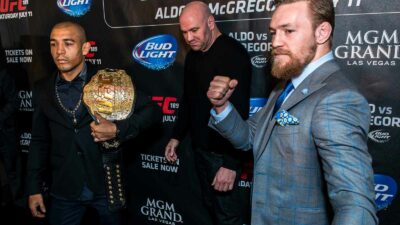Are you a UFC or MMA fan? Even hardcore fans won’t know all of these UFC trivia questions and facts.
The UFC has been called the “fastest-growing sport” in America and for good reason. Since the Ultimate Fighting Championship (UFC) was formed in 1993, the sport of Mixed Martial Arts (MMA) has grown from an amateur “fight club” to a serious rival to professional boxing. Even places like Las Vegas quickly took notice and UFC betting has also become one of the most popular sports betting options.
But how much do you really know about America’s fastest-growing sport? Are you up for a little UFC trivia? Even if you are a hardcore MMA fan, here are some things that you probably didn’t know about the UFC.
Even if you are a hardcore #MMA fan, here are some UFC trivia facts that you probably didn't know about the #UFC -- #UFCtrivia #MMAlife #UFCfights Share on XThe UFC Wasn’t Supposed To Be A Sport, Just A TV Event
The original idea behind the UFC was to see how two fighters who specialized in different martial arts performed against each other. For example, a boxer vs a sumo wrestler. The concept was appealing enough to get investors interested. A small group of investors gave organizers the funding they needed to start putting together UFC’s first TV event.
After being turned down by both HBO and Showtime (we bet they have some major regrets now), the UFC was able to secure Semaphore Entertainment Group (SEG) as their TV distribution partner. On November 12, 1993, the UFC broadcasted its first pay-per-view special. It was extremely successful and generated almost 90,000 paid subscribers. Producers immediately knew they were on to something big and organized multiple follow-up events. Along the way, the UFC popularized MMA and pushed its acceptance into being considered a sport.
- UFC Trivia: Both both HBO and Showtime rejected the first UFC event. The UFC evolved from a per-per-view TV event to a sport.
Senator John McCain Almost Banned The UFC
The idea behind the UFC was controversial from the beginning. Everyone from the media to politicians came out against the UFC. Senator John McCain, in particular, was a vocal opponent. He called the UFC “human cockfighting” and sent letters to every governor in the United States asking them to ban UFC events.
In 1997, 36 states came together to create laws that banned “no-holds-barred” fighting. The ban took place on the eve of UFC 12 forcing organizers to execute a costly last-minute relocation of the event from New York to Alabama. However, McCain’s efforts helped establish the rules and regulations that protect UFC fighters.
- UFC Trivia: Senator John McCain’s criticism of the UFC helped protect fighters and evolve the MMA into a legitimate sport.
The UFC Changed Ownership Four Times Between 1993-2016
The UFC has only existed since 1993. But in that short period of time, it has changed ownership several times.
- WOW Promotions (1993-1995): The UFC was originally created by a group of investors and business partners including Art Davie, Bob Meyrowitz, Campbell McLaren, David Isaacs, John Milius, and Rorion Gracie. After producing five successful pay-per-view events, WOW Promotions sold their interest in the UFC to their pay-per-view partners, SEG, in 1995.
- Semaphore Entertainment Group (1995-2001): The SEG ownership years were mostly plagued by legal battles. With Senator John McCain gaining support, the UFC struggled to find states that would let them operate. Even though SEG was ultimately successful in getting MMA accepted across most of the United States, the financial cost of the fight proved to be too much. SEG won the battle but lost the war. After fighting to get the UFC accepted between 1995-2001, SEG was on the edge of bankruptcy and sold the UFC for only $2 million dollars to Zuffa, a team of Las Vegas casino executives.
- Zuffa (2001-2016): Over the next 16 years, new UFC owners, Dana White, and the Fertitta Brothers (Frank and Lorenzo Fertitta) took the legal acceptance that SEG was able to achieve with individual states and turned the UFC into a money-making machine. They secured major sponsorships with brands like Anheuser-Busch and Harley Davidson, bought out MMA competitors including PRIDE and WEC, and launched a massive marketing campaign. They also took advantage of reality television as a marketing vehicle and gave MMA its first TV series, The Ultimate Fighter (TUF) on Spike TV in 2005. They were successful in turning MMA competition into a real sport and elevating the UFC to a household name without massive stigma.
- William Morris Endeavor (2016- ): But after nearly two decades, Dana White, the Fertitta Brothers decided to sell the UFC to William Morris Endeavor Entertainment LLC (WME-IMG). The entertainment company represents a wide range of entertainers from Adele to Conan O’Brien, but currently lacks sports personalities. The UFC helps fill that void and it will be interesting to see how they grow the sport in the coming years.
- UFC Trivia: Over the years, the UFC has been owned by promoters, entertainment companies, casino owners, and talent agencies.
Early UFC Fights Didn’t Have Many Rules Or Restrictions
The original tagline for the UFC was “There Are No Rules.” In the early days, the UFC wasn’t as regulated as it is now. There were only two rules: no biting and no eye-gouging. That was it. There were no weight classes. No illegal holds. No time limits. Anyone can fight anyone. Participants from all walks of life could come, fight, and test themselves against each other.
Between 1997-1999, the UFC made a variety of changes to appease state athletic commissions, save the sport and help protect the fighters (several cases of brain injuries had been reported). These changes included the introduction of weight classes, requiring gloves, and banning fish-hooking, groin strikes, hair pulls, hits to the back of the head or neck, and head kicks to a downed opponent.
- UFC Trivia: Between 1993-1997, there were only two rules for UFC fighters: no biting, and no eye-gouging.
The Unified Rules for MMA Has 14 Weight Classes
One of the biggest changes that the UFC made in the late 1990s was the introduction of weight classes. The days of watching skinny karate fighters battle sumo wrestlers were over.
Then in the year 2000, the official Unified Rules of Mixed Martial Arts were codified by the New Jersey State Athletic Commission. Any MMA event taking place in a state-sanctioned venue had to adhere to these rules and weight class definitions.
| Weight class | Upper weight limit |
|---|---|
| Strawweight | 115 lb (52.2 kg) |
| Flyweight | 125 lb (56.7 kg) |
| Bantamweight | 135 lb (61.2 kg) |
| Featherweight | 145 lb (65.8 kg) |
| Lightweight | 155 lb (70.3 kg) |
| Super lightweight | 165 lb (74.8 kg) |
| Welterweight | 170 lb (77.1 kg) |
| Super welterweight | 175 lb (79.4 kg) |
| Middleweight | 185 lb (83.9 kg) |
| Super middleweight | 195 lb (88.5 kg) |
| Light heavyweight | 205 lb (93.0 kg) |
| Cruiserweight | 225 lb (102.1 kg) |
| Heavyweight | 265 lb (120.2 kg) |
| Super heavyweight | N/A |
- UFC Trivia: Early UFC matches didn’t have weight class restrictions.
UFC Management Didn’t Think Women’s MMA FIghts Would Be Popular
Dana White, UFC president, was initially against women fighting in matches. He didn’t think women’s MMA fights would be successful. He was very, very, wrong, and openly admits it.
Fans ended up loving female fights and the sport has gone on to produce well-loved female fighters like Amanda Serrano, Amanda Nunes, Miesha Tate, and Ronda Rousey. Woman’s matches are also some of the most popular when it comes to UFC betting by sports gamblers.
- UFC Trivia: Initially, UFC executives didn’t think women’s matches would be a good idea. They were very wrong.
Conor McGregor’s Net Worth is Over $110 Million Dollars
The “Mystic Mac” of the UFC, Conor McGregor, went from making $100 per fight to $100 million. He’s not only the highest-grossing MMA fighter in history but currently the 4th highest-paid athlete behind Floyd Mayweather, Lionel Messi, and Cristiano Ronaldo. According to CelebrityNetWorth, the Irish born fighter’s net worth is currently estimated at around $110 million dollars.
In addition to the prize money that he earns from his fights, McGregor generates money through sponsorships and other side-ventures. His sponsors include brands like Burger King, Beats by Dre, Monster Energy, David August, BSN, Anheuser-Busch, HiSmile and Betsafe. He also has a residency deal with Wynn Las Vegas for all of his after parties and several digital apps and properties including Conor McGregor FAST Program, MacMoji (app), MacTalk (app), and the Mac Life.
In March 2019, McGregor announced on Twitter that he was retiring from MMA fighting and that he was launching his own brand of Irish whiskey called Proper Whiskey.
- UFC Trivia: Popular UFC fighters like Conor McGregor are some of the most financially successful athletes in sports history.
Self-Defense Helps Drive Interest In MMA
For many professional MMA fighters, their initial interest in the sport as a means to protect themselves from bullies. When they started training, most of them had no idea that they would end up using their skills to make a living like Georges St. Pierre (GSP) or Conor MacGregor. It was only later that these athletes realized they could make a career out of physically protecting themselves!
- UFC Trivia: Many UFC athletes started learning MMA as form of self-defense.
NERD NOTE: The roots of MMA can be traced back to ancient Greece. As part of their training, Greek soldiers learned an ancient martial art called pankration, a mix of wrestling, boxing, and street fighting.
Related Articles:
- Oh No! Goose Fight With An Unexpected Ending
- Canadian Easter Egg Hunt Turns Violent
- Top Banned Movie Posters of All-Time (NSFW)
- Oops! Guy Almost Walks Into a Bear While Texting And Walking

Frank Wilson is a retired teacher with over 30 years of combined experience in the education, small business technology, and real estate business. He now blogs as a hobby and spends most days tinkering with old computers. Wilson is passionate about tech, enjoys fishing, and loves drinking beer.












 Comparing Physical Slot Machines To Their Virtual Counterparts
Comparing Physical Slot Machines To Their Virtual Counterparts
Adding women was the smartest thing they’ve ever done